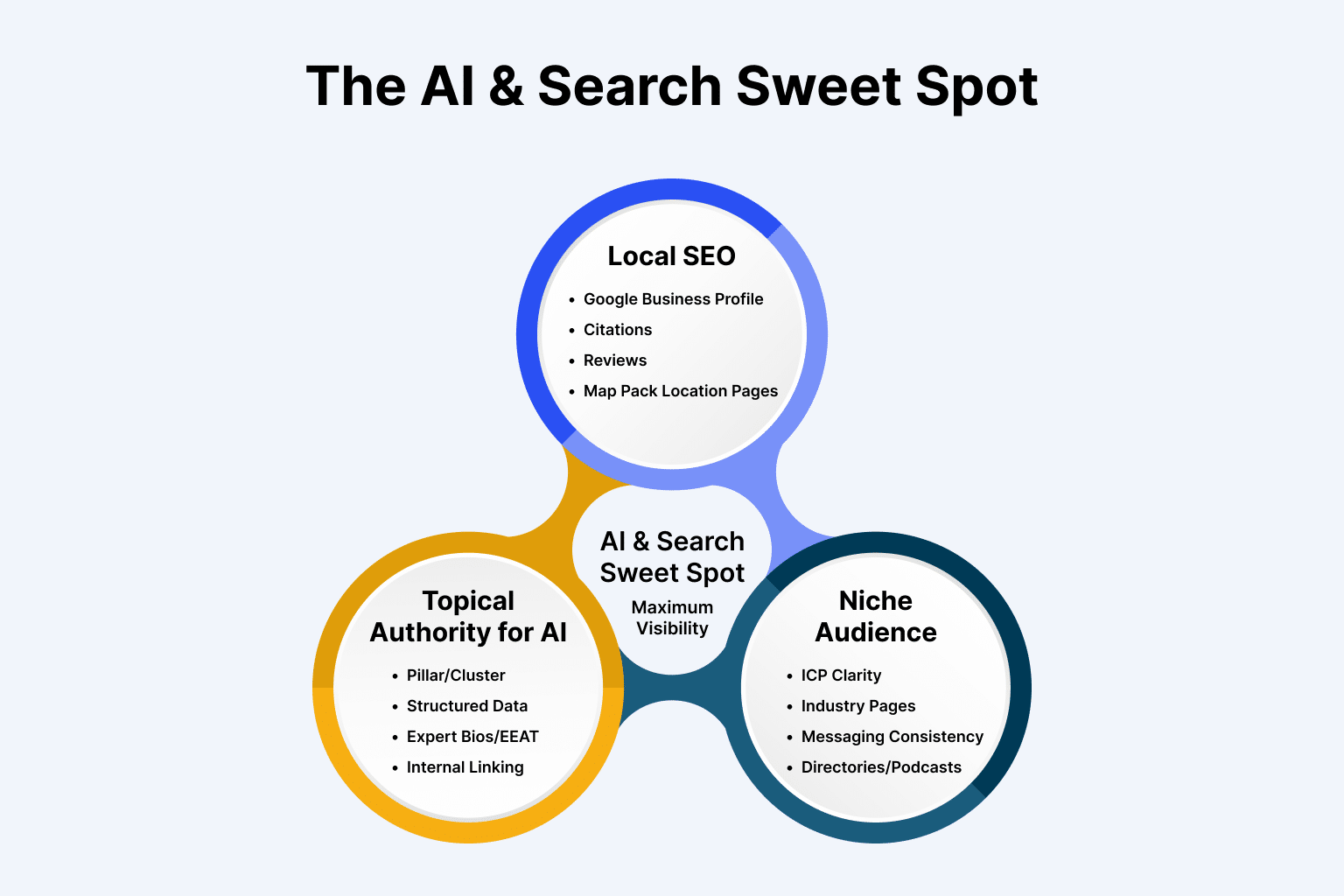The Search Shift Advisors Can’t Ignore
AI-driven search tools like ChatGPT, Google’s AI Overview, and Perplexity are changing how prospective clients find financial advisors. It’s no longer enough to just show up in traditional search results – your firm needs to be recognized and clearly defined by AI systems.
That’s where the Who–What–Where statement comes in (also known as an AI Entity Statement). Think of it as your digital elevator pitch, crafted for both humans and algorithms. In one clear sentence, it tells search engines (and readers) who you are, what you do, and where you do it. And when done well, it becomes the foundation of your AI visibility strategy.
What Is a Who–What–Where Statement?
A Who–What–Where statement is a short, structured sentence that clearly defines your firm: who you are, what you do, and where you do it. In the world of AI search, this simple line carries big weight.
Think of it as your firm’s digital business card – the first thing AI systems like ChatGPT, Perplexity, or Google’s AI Overview look for when deciding how to categorize your business and whether to include you in an answer.
Here’s a basic structure:
[Firm Name] is a [business type] in [location], helping [target audience] with [services or outcomes].
And a real example:
Defiant Capital Group is an independent wealth management firm in Pittsburgh, Pennsylvania, helping founders, business owners, and affluent families with complex financial lives navigate investment and planning decisions.
That one sentence does a lot of work:
- Establishes the firm’s identity
- Clarifies its geographic focus
- Highlights its core services and audience
It’s the foundation of your AI entity recognition – a key signal that tells search engines exactly who you are and which queries you should show up for.
Why It Matters More Than Ever
AI-powered search engines are changing how clients discover financial advisors. Tools like Google’s AI Overview, ChatGPT, and Perplexity don’t just scan keywords – they look for clear, structured definitions of businesses. That’s where your Who–What–Where statement comes in.
This one sentence helps AI systems:
- Recognize your firm as a real entity (not just a phrase or generic name)
- Distinguish you from similar-sounding competitors in other regions
- Match your firm to high-intent queries like “best financial advisor in Pittsburgh for business owners.”
Think of it like this:
When someone types “financial advisor for business owners in Pittsburgh with complex financial needs,” AI needs to know:
- That you’re a financial advisor
- That you’re in Pittsburgh (or serve the Pittsburgh area)
- That you help business owners and families with complex financial lives
If your Who–What–Where statement says all of that clearly – and it’s used consistently across your website, Google Business Profile, and directories – you’ve just made it a lot easier for AI to recommend your firm.
And the benefits go beyond AI:
- Improves your local SEO performance
- Strengthens your brand positioning
- Makes your messaging more consistent and credible across platforms
10 Best Practices for Writing Your Who–What–Where Statement
Writing a strong Who–What–Where statement is more than just filling in the blanks. These best practices help ensure your statement is clear, effective, and optimized for AI-driven search.
- Stick to the Who–What–Where Format
Start with your firm’s name, then describe what you do and where you’re based or serve clients. Add who you help or what you specialize in, if relevant.
Example: Defiant Capital Group is a wealth management firm in Pittsburgh, Pennsylvania, serving founders, business owners, and affluent families with complex financial needs.
2. Keep It Between 20 – 40 Words
Short enough for AI systems to parse quickly, long enough to provide useful context. Think of it as a single, well-crafted sentence.
3. Use Clear, Descriptive Language
Avoid vague marketing language. Terms like “wealth management,” “financial planning,” and “retirement” give AIs concrete signals.
4. Include Geographic Context
Mention your city and state – or the region you serve. This improves local SEO and prevents confusion with similar firms elsewhere.
5. Highlight Your Core Audience
AI increasingly matches firms to audience-specific queries. If you serve executives, business owners, or retirees, say so.
6. Add a Niche or Differentiator (If Relevant)
Specializing in equity compensation, tax planning, or exit strategies? Include it only if it’s a consistent part of your positioning.
7. Be Consistent Across the Web
Use the same sentence (or slight variants) on your homepage, About page, Google Business Profile, schema markup, LinkedIn, your author bio, and directories.
8. Avoid Acronyms or Abbreviations
Spell out your full business name unless the acronym is well-established and widely used in your marketing.
9. Don’t List Multiple Cities
Instead of listing every location, reference a broader region: “serving the Pittsburgh area” or “based in Western Pennsylvania.”
Update As Your Business Evolves
If you expand your service area or change your niche, update your Who–What–Where statement to reflect your current focus.
Why Your Who–What–Where Statement Sets the Tone for All Your Content
The most effective advisor marketing aligns around three positioning angles:
- A niche audience (like tech executives, business owners, or physicians)
- A local audience (like Pittsburgh, Austin, or the Twin Cities)
- A specialized service (like stock compensation, exit planning, or retirement tax strategies)
Your Who–What–Where statement is where that positioning begins. It’s the line that tells search engines – and potential clients – who you serve, what you specialize in, and where you’re based. That clarity shapes your entire visibility strategy.
A Quick Note on Content Clusters
Your Who–What–Where is the top-level anchor- but your content clusters don’t have to repeat the full statement. Instead, they expand on key parts of it.
For example, if your “what” is retirement planning, your content clusters might focus on:
- Roth conversions
- Social Security strategies
- Retirement income planning
- Charitable giving
- Tax efficiency in retirement
Each topic reinforces your core identity without needing to restate the full entity description.
Bottom line: The Who–What–Where sets the direction. Your content clusters build depth and authority around the areas that matter most to your audience – and to AI.
Where to Use Your Who–What–Where Statement
Writing a strong Who–What–Where statement is just the start. The real power comes from using it consistently across the web so AI systems and search engines can recognize your firm with confidence.
Here’s where to place it:
- Your Website (Homepage + About Page): Use it as the opening line in your About section or near the top of your homepage. This helps visitors and AI crawlers understand your positioning right away.
- Schema Markup: Add it to your site’s structured data (often handled by your SEO plugin). It goes in the “description” field of your FinancialService schema to help Google index your entity accurately.
- Google Business Profile: You get 750 characters in the business description field – include a slightly shortened version of your Who–What–Where in the first 1–2 sentences for maximum visibility.
- Advisor Directories: Sites like SmartAsset, Wealthtender, FeeOnlyNetwork, and others all include firm bios. Use your statement as the foundation, then build from there.
- LinkedIn (Company Page + Bios): Your firm’s LinkedIn “About” section and team member bios should start with a variation of your Who–What–Where. It signals consistency and reinforces your niche.
- Author Bios: Whether you’re publishing blog articles on your own site or contributing to third-party outlets, include your Who–What–Where in the first sentence of your bio to reinforce your authority and visibility.
- Podcasts, Press, and Guest Bios: When submitting a speaker intro or guest profile, lead with your Who–What–Where to instantly communicate who you are and who you serve.
The goal: Build repetition across trusted platforms so AI systems can confidently say, “This is who they are – and here’s what they’re known for.”
Frequently Asked Questions
1. What is a Who–What–Where statement?
A Who–What–Where statement (also known as an AI Entity Statement) is a short, structured sentence that clearly defines your firm by stating who you are, what you do, and where you’re located. It’s used by AI and search engines to categorize and recommend your business.
2. Why does my firm need a Who–What–Where statement?
It helps your firm show up in AI-powered search tools like Google’s AI Overview, ChatGPT, and Perplexity. Without a clear, consistent statement, your firm may be overlooked or confused with other similarly named businesses.
3. Where should I use my Who–What–Where statement?
You should use it across your website (especially on your homepage and About page), Google Business Profile, schema markup, LinkedIn, author bios, and advisor directories. Repetition helps AI systems confidently identify and recommend your firm.
4. How long should a Who–What–Where statement be?
The ideal length is 20–40 words. It should be long enough to provide meaningful context but short enough to be easily parsed by search engines and AI tools.
5. Does my Who–What–Where statement affect SEO?
Yes. It strengthens both local SEO and entity-based SEO by helping search engines understand your firm’s identity, location, and expertise. It also improves your visibility in high-intent search queries.
6. Can I have more than one Who–What–Where statement?
You should have one core statement for consistency across platforms. However, it’s fine to use shortened or slightly customized versions depending on the format (e.g., schema, LinkedIn, or Google Business Profile).
Small Statement, Big Impact
In an AI-driven search landscape, visibility isn’t just about keywords – it’s about clarity.
A well-crafted Who–What–Where statement helps define your firm in the eyes of both search engines and prospective clients. It improves your chances of being discovered in AI-generated answers, strengthens your local SEO, and sets the tone for all your content.
It may seem like a small detail – but it plays a big role in how you’re perceived, found, and ranked online.
Ready to Strengthen Your Visibility?
If your firm’s Who–What–Where statement needs clarity, consistency, or a fresh perspective, we can help.
- Want to make sure your statement supports your niche and local strategy?
- Need help deploying it across schema, directories, or AI profiles?
- Or just want expert eyes on how it fits into your content plan?
Schedule a free visibility audit or contact our team – we’ll help you show up in the moments that matter.
Brent is the Principal and founder of Advisor Rankings - a specialized SEO and AI search optimization agency dedicated to helping independent financial advisors strengthen authority, boost traffic, and attract high-quality leads online. He holds an MBA in Financial Planning, giving him a strong foundation in the technical side of the profession. With more than a decade of experience specializing in SEO for advisors, Brent bridges financial knowledge with digital marketing expertise. He has presented at NAPFA, FinCon, and XYPN, and appeared on several industry podcasts, including the Financial Advisor Success Podcast with Michael Kitces.
- Brent Carnduffhttps://advisorrankings.io/author/brent/
- Brent Carnduffhttps://advisorrankings.io/author/brent/
- Brent Carnduffhttps://advisorrankings.io/author/brent/
- Brent Carnduffhttps://advisorrankings.io/author/brent/



